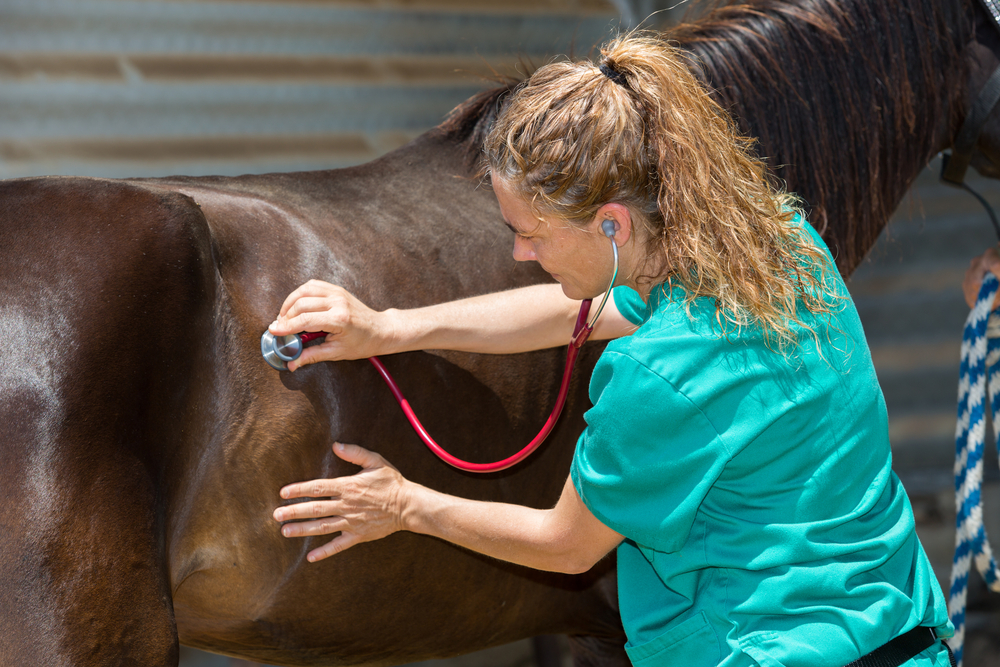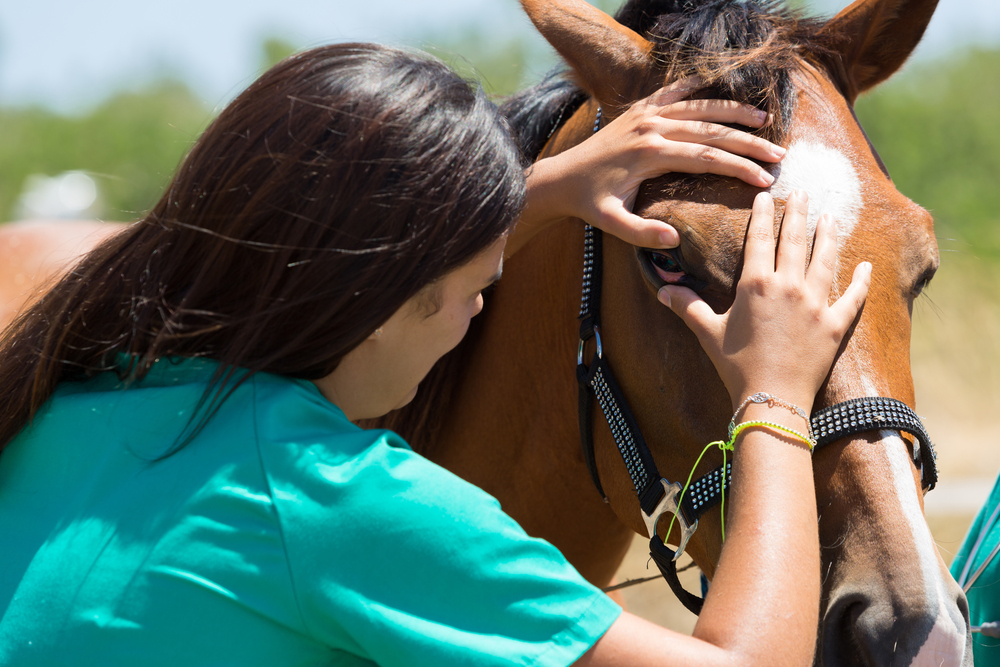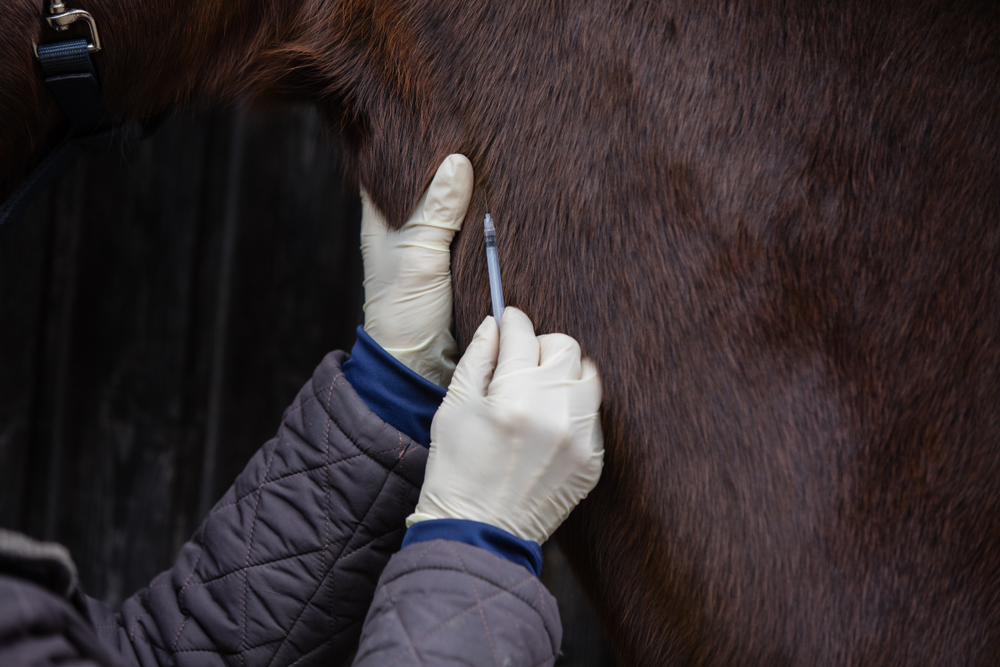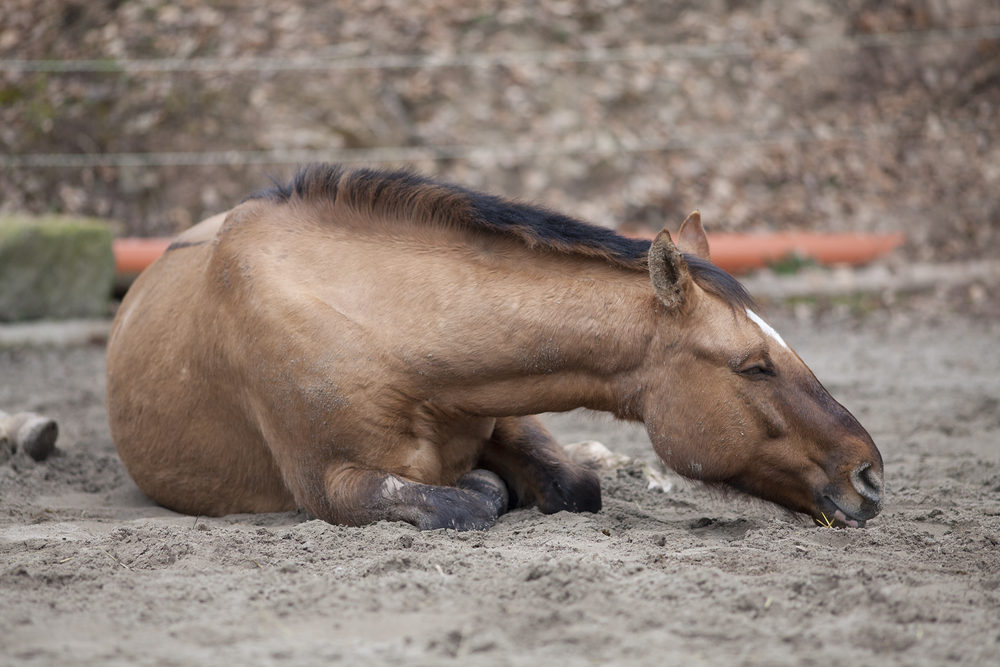- Your source for stall mats, rubber arena footing, arena harrows and arena dust control.

Horses can develop health problems at any stage in their life. Infectious horse diseases are what horses get from each other or through a mosquito or tick and can also be transmitted between horses. Here listed are some of the most common horse diseases and ailments.
The most common contagious horse diseases that horses can get are:
- Equine Encephalomyelitis (Sleeping Sickness)
- Equine Herpesvirus (EHV)/Rhinopneumonitis
- Equine Influenza (Flu)
- Equine Piroplasmosis
- Equine Protozoal Myeloencephalitis (EPM)
- Equine Viral Arteritis (EVA)
- Potomac Horse Fever (PHF)
- Rabies
- Rhodococcus equi
- Streptococcus equi (Strangles)
- Tetanus (Lockjaw)
- West Nile Virus
Knowing about and treating horse diseases and ailments are essential parts of horse management . Here we discuss the critical equine infectious diseases and ailments that can make your horse sick, how they are spread, and how to prevent them.
. Here we discuss the critical equine infectious diseases and ailments that can make your horse sick, how they are spread, and how to prevent them.
Common horse diseases
Equine Encephalomyelitis (Sleeping Sickness)
This disease is caused by a virus, which is transmitted by mosquitos. Encephalomyelitis causes inflammation of the brain and spinal cord and can be fatal. Sick horses will lose their appetite and display excitable or compulsive behavior and walk blindly into objects. Horses surviving this virus can suffer permanent damage.
This virus has three strains. The first is Eastern (EEE); it is the deadliest, killing 75-100% of infected horses. The second one is Western (WEE) and is more common and somewhat less virulent. Both EEE and WEE occur throughout the U.S, and horses should be vaccinated for both strains.
The third strain is the Venezuelan strain (VEE), and vaccination recommendations have been issued for horses living in the southern states, especially those bordering Mexico. Vaccination is very effective against the disease. It is recommended to give the vaccine annually.
Equine Herpesvirus (EHV)/Rhinopneumonitis
From the many equine herpes viruses identified, Type 1 (EHV1) and Type 4 (EHV4) are the most clinically important. Equine Herpes Virus is characterized by respiratory infections, abortions paralysis, inflammation of the spinal cord, and often death in young horses. Equine Herpes Virus is highly contagious, spreading through aerosolized secretions, contact with infected horses, and contaminated water and feed utensils.
Even though the EHV vaccine is not 100% effective and protection will only last for around 12 weeks, your horse should be vaccinated. All pregnant mares should be vaccinated at 5, 7, and 9 months from their breeding date. All horses that are traveling to races, shows, sales should be vaccinated every six months. Horses that do not travel can be vaccinated annually. EHV vaccine does not protect against the neurologic form of the disease.
Equine Influenza (Flu)
Equine Influenza is a contagious virus that causes high fever, nasal discharge, coughing, and loss of appetite. Infected horses have to be kept at complete rest to avoid complications such as pneumonia.
The Equine Influenza virus mutates into new strains over time, and several strains are circulating in the U.S. Horses should receive a vaccine containing the most current influenza strains available. Horses traveling to shows and racing events should be vaccinated every six months. Horses that do not travel can be vaccinated annually.
Equine Piroplasmosis
Equine piroplasmosis is caused by two primary organisms, Theileria equi and Babesia caballi. These organisms are primarily transmitted by ticks but can also spread between horses through contaminated transfusions and needles.
Clinical signs of Equine piroplasmosis are weakness, loss of appetite, anemia, fever, weight loss, edema, and jaundice. Some horses who survive this condition can carry and shed the parasite for long periods and can infect other horses through tick exposure.
A blood test should be done to diagnose this condition. Due to the seriousness of Equine piroplasmosis, infected horses must be reported, and mandatory testing is required for specific events like the AQHA World Show and Quarter horse Congress. Unfortunately, there is no vaccine currently available. Even though treatment is possible, it requires special regulatory permission.
Equine Protozoal Myeloencephalitis (EPM)
Equine Protozoal Myeloencephalitis or EMP Is a disease that affects the central nervous system of a horse. It is caused by the parasite Sarcocystis neurona and sometimes Neospora hughesi. Signs of EPM include seizures, muscle atrophy, depression, incoordination, lameness, and paralysis.
Equine Viral Arteritis (EVA)
Equine Viral Arteritis or EVA is a contagious disease often occurring in an epidemic form on breeding farms, race tracks, and shows. EVA is most severe in young and old horses, as well as horses under extreme stress. Clinical signs of EVA include fever, depression, coughing, leg, facial swelling, high rates of abortion, and sometimes death.
Potomac Horse Fever (PHF)
Potomac Horse Fever is named after the region where it was first diagnosed in 1979. This horse disease includes a high fever, laminitis, severe diarrhea, edema, and death. PHF is caused by the parasite Neorickettsia risticii. Horses easily get infected through tiny land snails and mayflies that carry the parasite.
Infections occur most often during the summer months in the northeast U.S. PHF is not contagious and occurs more commonly in wet areas. PHF vaccine is effective and is given once a year, depending on exposure risk. The vaccine is administered 2-4 times a year in problem areas.

Rabies
Rabies is a fatal viral disease that infects the nervous system of mammals. All mammals, including humans, are susceptible. Rabies is contracted from the saliva or bite of an infected animal. Rabies is spread primarily by raccoons, bats, skunks, coyotes, and foxes. In northeast Ohio, rabies has been found in both wild and domestic animals. The vaccine is very effective and is given once a year.
Rhodococcus equi
Rhodococcus equi causes pneumonia in young foals from up to 4 months of age. Rhodococcus equi is characterized by large abscesses that form in the horse’s lung, making treatment challenging. Soil-borne bacteria cause it. When bacteria multiply in the respiratory tract, it is coughed up and swallowed, resulting in soil contamination through infected feces.
Clinical signs of Rhodococcus equi include fever, cough, and labored breathing. Abscesses can form outside of the lungs in areas such as the spine or under the skin. Unfortunately, there is no vaccine available for this condition.
High-risk foals can receive ultrasound screenings and be given hyperimmune plasma to minimize their risk. A combination of antibiotics is often used for the treatment of Rhodococcus equi. The prognosis for this condition, when caught early, is good to poor.
Streptococcus equi (Strangles)
Strangles are most often found in young horses, though horses of all ages can be affected. Strangles is a highly contagious bacterial disease caused by Streptococcus equi. Symptoms of Strangles include high fever, nasal discharge, abscessed lymph nodes, loss of appetite, cough, swollen lymph nodes in the throat, and trouble swallowing.
The enlarged inner lymph nodes may impair breathing or even asphyxiate a horse. Horses can also develop guttural pouch infections, purpura hemorrhagica, sinus infections, and laryngeal paralysis.
Strangles are transmitted via nasal secretions, flies, pus from draining abscesses, contaminated feed buckets, and dirty grooming tools. There is an intranasal vaccine available which is more effective than the intramuscular vaccine. The Strangles vaccine is usually given every 6 to 12 months for high-risk horses.
Tetanus (Lockjaw)
Tetanus or Lockjaw is a disease caused by a bacterial toxin (Clostridium tetani) which usually enters the horse’s body through wounds from barbed wire, dropped nails, or even surgical procedures like castration.
The bacteria are also found in horse manure. Tetanus is recognized by spasmodic contractions and rigidity of some muscles like that in the horse’s jaw and face.
Affected horses will suffer from a high fever, violent reactions to sudden movement or noise, and even death from asphyxiation. Tetanus is almost always fatal. The vaccine is very effective and should be administered once a year. A booster is also given in case of laceration, surgery, or penetrating wounds.
West Nile Virus
This mosquito-borne disease was first discovered in New York in 1999 and has spread quickly throughout the U.S. West Nile virus causes encephalitis (inflammation of the brain and spinal cord), partial paralysis, muscle weakness, fever, convulsions, coma, and death.
Once a horse shows clinical signs of West Nile virus, the disease is fatal nearly 40% of the time. Horses that travel to risk areas like the southern states should receive a booster two weeks before traveling. Vaccination is recommended in the spring yearly.
Horse vaccinations
Vaccinations are available for most of the conditions listed above. Vaccines are preparations of killed microorganisms and living weakened microorganisms. When introduced into the horse’s body, they produce immunity to a specific disease by causing the formation of antibodies. Vaccines are delicate compounds, which, if handled or administered incorrectly, will be ineffective or neutralized. Always discuss vaccination protocols and other prevention strategies with your veterinarian.

Common Horse Ailments
Skin conditions
Ringworm
Ringworm is a highly contagious fungal infection of the skin that can spread by direct or indirect contact. Infected horses should be isolated as soon as possible, strict hygiene measures must be adopted and veterinary treatment sought. Ringworm infection shows up initially as tufts of raised hair, eventually falling off, leaving weeping lesions on a horse’s skin.
Circular in shape, these lesions can vary in size and density and usually occur around the head, neck, saddle, and girth regions of the horse. The horse’s immediate environment will also become infected, bedding material should be destroyed, stable, and horse-riding equipment should be washed thoroughly with a fungicidal disinfectant.
Rain scald
Rain scald, also known as mycotic dermatitis or rain rot, is a skin infection caused by a softening of the skin after persistent saturation. Rain scald occurs in horses with weakened immunity or horses who are already in poor condition. These horses lack the natural grease in their coat to keep warm and dry.
Rain scald can also occur when leaking or non-breathable turnout rugs are used, when there is poor air circulation under the rug or when the horse’s back is constantly getting wet with moisture from sweat or rain.
An affected horse will show patchy hair loss along the back and quarters. The horse’s hair can become matted, and the skin can develop weeping lesions and sores.
To prevent a horse from getting rain rot, ensure that the horse always has access to a field shelter. All horse rugs should be without holes and maintained accordingly.
Read more on rain rot and whether you can ride a horse with rain rot .
.
Mud fever
Mud fever is a skin condition found in horses that are usually associated with wet and muddy conditions. The skin of the stomach and legs of a horse will become inflamed and scaly. In severe mud fever cases, the horse may develop a high temperature. Mud fever is caused by bacteria that enter the wet skin and cause scabs to form, sealing in the infection.
Always ensure that your horse’s legs are well cleaned after work or time in the field. Wash off and ensure that the horse’s legs are correctly dried. Another option is to leave the mud to dry and then brush it off with a soft brush. You might want to apply a barrier cream to prevent the skin from becoming waterlogged if your horse is clipped.
Sweet itch
Sweet itch is an inflammation of a horse’s skin due to an allergic reaction, which is also called Summer Seasonal Recurrent Dermatitis (SSRD). Sweet itch is caused by a biting midge called Culicoides. An allergic reaction to the saliva of the midge is what causes the itching.
In many cases, the horse will become itchy on the back, especially around the mane and tail. In extreme cases of sweet itch, the horse can rub the skin raw to relieve the itching.
Susceptible horses usually develop the condition for the first time as youngsters and, once it has occurred, the horse will continue to suffer from it.
Cracked heels
The same conditions as mud fever can cause cracked heels. It is recommended to keep the horse’s legs and stomach as clean and dry as possible. You might want to apply a protective cream that will also help.
You should take extra care when dealing with heels because they are close to the ground and therefore more susceptible to becoming waterlogged. Always ensure that your horse’s legs are cleaned well after work or time out in the field.
Respiratory conditions
Common cold
Viruses and bacteria can cause upper respiratory tract (URT) infections. Stress, frequent contact with many horses are all risk factors.
The common cold in horses is usually indicated by a yellow or white discharge from the nose. A slightly higher than usual temperature might be present, and the horse’s glands may become swollen.
The common cold is usually caused by a viral infection contracted by contact with other infected horses. Horses may become more susceptible if they are kept in a poorly ventilated stable for long periods.
Horses often catch colds if they are competing at shows due to the proximity of other horses from different areas of the country.
It is essential to call the veterinary surgeon immediately and keep the horse isolated as the virus can spread to other horses. Keep the horse warm and in a well-ventilated, dust-free area.
Try to feed soft food that is easy to swallow and well-soaked hay. Try not to let your horse drink from public water troughs at competitions; always take your water supply and feeding bowls.
Allergies
Allergies to dust and insect bites are relatively common horse health problems. However, the severity of the allergy might vary. Dust allergies can cause COPD (chronic obstructive pulmonary disease). It is a severe respiratory disease that can require steroid therapy to reduce inflammation and mucus buildup.
Some allergies result in skin irritation known as urticaria. This condition is prevalent alongside insect bites and stings and can look like nettle rash. The horse’s skin is covered with small swellings and looks lumpy but usually subsides on its own. However, occasionally treatment with antihistamines may be needed.
Coughing
Three main types of coughs can occur in horses. The first is usually associated with a common cold which generally starts with the occasional cough accompanied by a watery discharge from the horse’s nose. After approximately two weeks, the discharge will change color to white or yellow, and the cough will increase in frequency. The other two types are coughs in horses are caused by a viral or bacterial infection.
If your horse is coughing and stabled, ensure that the bedding is dust-free and hay has been soaked. The stable should be well ventilated.
Never ride or work a horse that is coughing. It is also advisable to keep your horse away from other horses until the type of cough has been identified by a veterinarian, as types one and two can be infectious.

Other common horse ailments
Colic
Colic is the term used to describe abdominal pain in horses. Colic can indicate a problem with the horse’s gut itself or other organs within the abdomen. There are many causes of colic, from simple indigestion to a seriously twisted gut. In all cases of suspected colic, you should immediately contact your veterinarian.
Signs of colic include
- restless horse, pawing at the ground or attempting to roll excessively
- unexplained sweating and rapid or difficult breathing
- unusually irritable, looking at or attempting to kick its stomach
- stretching as if to urinate or attempting to pass dung without result
- elevated pulse rate and temperature.
Laminitis
Laminitis is a painful and debilitating condition found in horses. When not treated quickly or correctly, laminitis can cause permanent damage, which may result in euthanasia. Laminitis is the swelling of the laminae, the soft tissue under the hoof wall. Laminitis can be caused by indulging in rich grass in the spring, overeating grain, or trauma to the hoof.
Once a horse had laminitis, they are most likely to develop it again. Laminitis is a painful condition that causes a horse to become lame as the laminae tissue swells and presses on the hoof wall. Laminitis can be severe, and early veterinary attention is critical.
Signs of acute laminitis include
- increased digital pulse in the lower limb
- lameness with an inability or reluctance to walk or move
- lying down and displaying an unwillingness to get up
- rocking back onto heels when standing, limbs outstretched
- leaning back onto hind feet to relieve pressure from the front feet
Thrush
Thrush is an infection of the frog, the V-shaped groove in the sole of the horse hoof. Thrush is easy to detect as the hoof will produce a distinct foul smell. To prevent thrush, you should keep the horse’s feet clean and dry by picking them out regularly.
Thrush rarely requires veterinary treatment and will usually go away after a thorough cleaning and a few applications of antibacterial spray. However, a severe case of thrush can migrate up into the hoof. Sometimes a poultice to draw the infection out and a round of antibiotics to kill the infection is necessary.
Parasites
Worms are a common ailment amongst horses, especially horses that graze out in fields. Worms can cause weight loss, dull coats, and lethargy in horses. Worms can also form blockages in the intestinal tract that could lead to colic.
Horses should be treated with a deworming product every three to four months. It is recommended to use products that contain ivermectin, pyrantel, and fenbendazole.
Painful back
Back problems are widespread in horses. A painful back is usually the result of an ill-fitting saddle but can also develop when a horse pulls a muscle or ligament when the horse falls or rolls. The horse’s spine can become tender and painful. You might notice swelling or heat around the affected area.
Physiotherapy can treat some back problems. Always have your veterinarian assess any horse back problems. Your veterinarian will be able to determine if x-rays or ultrasounds are necessary for an accurate diagnosis. Treating horse back problems is often a team effort that involves the veterinarian and farrier.
Cushings
Equine Cushings disease, also known as Pars Pituitary Intermedia Dysfunction (PPID), is a disorder of a horses’ endocrine system (hormonal system). Equine Cushing’s disease is the enlargement of the middle section of the pituitary gland.
The enlargement of the pars intermedia results in the increased release of several hormones. The hormone ACTH or adrenocorticotropic hormone causes the adrenal glands near the kidneys to increase cortisol production, a type of steroid—this over-production of cortisol cause most of the clinical signs we see in a Cushings disease horse.
Horses diagnosed with Cushings disease have a diminished capacity to receive and send the dopamine signal due to neurodegeneration (decaying of nerves).
Read more on cushings disease and whether you can ride a horse with cushings disease .
.
Conclusion
All of the common horse diseases and ailments listed above can affect your horse. Prevention, identification, and treatment of the diseases that commonly affect horses should be studied by anyone considering taking on the responsibility of owning a horse. Always call your veterinarian immediately whenever you notice any health-related issues with your horse.
Sources
https://www.dominionequineclinic.com/common-diseases
https://equissavefoundation.org/8-common-health-problems-in-horses/
https://www.bluecross.org.uk/pet-advice/common-ailments-and-health-problems-horses
https://www.lisbonvetclinic.com/infectious-diseases.pml
Other articles in this series:
Horse Living Environments: A Comprehensive Guide
Feeding Your Horse: A Comprehensive Guide
How To Groom Your Horse: The Ultimate Guide Horse Veterinary Care: The Complete Guide
Horse Veterinary Care: The Complete Guide

